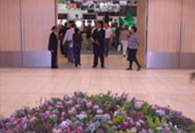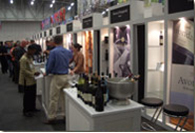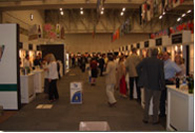 |
| Cape Town International Convention Centre |
For the fourth time, winemakers, traders, importers and wine experts met at South Africa's most important wine fair. After 2004, Cape Wine was again held at the Cape Town International Convention Centre (CTICC). The event was scheduled for three days, from 4 to 6 April 2006. The first day was dedicated exclusively to a conference on nature conservation and biodiversity. Only on the second and third days could wines be tasted - unfortunately too little time to do justice to the abundance of wineries and wines.
Nevertheless, the wine fair was once again excellently organised by "Wines of South Africa" (WoSA). The waiting times were short and the wineries presented themselves clearly sorted by growing regions.
At Cape Wine 2004, one day of the fair was still open to the public. This year, however, this regulation was abandoned and Cape Wine became a trade fair for visitors only.
Once again, all producers of distinction were represented. But also some new wineries presented themselves. In addition to new wines and new vintages, high-class wines and barrel samples of wines that are not yet on sale were presented. Wines that have been the talk of the town in recent weeks and months could also be tasted. These include the Cirrus Syrah from Engelbrecht Els and the Anwilka, praised by Robert Parker, which is a cooperation of two winemakers from Bordeaux and Klein Constantia.
The numerous winemakers who were there in person always left the opportunity for technical discussions. Even Michel Rolland, who advises some South African wine estates and owns shares in a South African wine estate, was on site.
 |
| Clearly arranged according to growing regions |
At the upper end of the price and quality scale, the wines of Engelbrecht Els were convincing. The top cuvée of the house, the Ernie Els 2003, is a cabernet-sauvignon-dominated cuvée. The wine is dark and firm with a nice spiciness and an almost endless finish. We rated it with 93 points. Even slightly better in our eyes is the Cirrus Syrah 2003. It shows a very fine nose with dark juicy fruit notes and meat. On the palate, it is creamy and fine, yet powerful. The finish is very harmonious and wonderfully long. We have rated the Cirrus Syrah 2003 with 93-94 points. Unfortunately, the wine is already sold out. The second cuvée of the house, the Proprietor's Blend 2004 is a cuvée of mainly Cabernet Sauvignon and Syrah, which presents itself with clear fruit, powerful spice and a wonderful persistence. We awarded 92 points.
The wines from Rustenberg were equally impressive. Already the regular Chardonnay (vintage 2005) shows how balanced and defined a barrique Chardonnay from South Africa can be. The single-vineyard variant "Five Soldiers" (2004 vintage) has extra dimension and depth. The winery's flagship wine, Peter Barlow, is a single-varietal Cabernet Sauvignon. The 2001 and 2003 vintages were presented at Cape Wine. Both wines show lots of sweet fruit, depth, finesse and first class integrated tannins. Both vintages will still be fun to drink 10 years after the harvest. Only the Straw Wine cannot quite keep up. It has plenty of sweetness and is long-lasting, but unfortunately lacks buffering acidity.
The young family winery Bein from Stellenbosch produces exclusively a Merlot, which was presented in the vintages 2003 and 2004. Two vintages could not be more different. The 2003 tends towards "Old World" with vegetal notes and strong tannins. The 2004 is a typical South African Merlot with sweet fruit, density, creaminess and juice.
The wines from Veenwouden were not of the expected high quality. However, this may also be due to the fact that the weak 2002 vintage was hired. Other wineries did not bottle their 2002 wines at all or not under the main label. Meerlust, for example, labelled its 2002 Rubicon only as "Meerlust Red". But special attention should be paid to the third wine from Veenwouden, the Thornhill Shiraz. The vineyards are on the Thornhill estate of winemaker Marcel van der Walt. The 2003 vintage presented is an amazing wine. It still shows a little hollow on the mid palate, but this is most likely due to the young age of the vines. However, when they come of age, great things can emerge here.
 |
| Only trade visitors were admitted |
The Anwilka, highly praised by Robert Parker, could be tasted at the Klein Constantia stand. It is a blend of 63% Cabernet Sauvignon and 37% Syrah from vineyards in the Helderberg region of Stellenbosch. The wine was aged for nine months in barriques. Anwilka is a collaboration between Bruno Prats (formerly of Château Cos d'Estournel), Hubert Boûard (Château Angelus) and Lowell Jooste of Klein Constantia. Wine guru Robert Parker tasted this wine during an en primeur tasting in Bordeaux and wrote about it that it was the finest South African wine he had ever had in his glass. With this statement, however, Parker shows that he obviously does not taste many South African wines. The Anwilka is a really good wine, but it is not the finest South Africa has to offer.
One of the best wineries in South Africa was, of course, on site again: Vergelegen. Hardly any other winery manages to produce such a broad portfolio of such high quality. Three wines show up at the top: the Sauvignon Blanc Reserve 2005, the Vergelegen 2002 as well as the "V". The Vergelegen "V" is a pure Cabernet Sauvignon and is meant to compete with the great red wines of the New World, namely Grange or Opus One. It is extremely fine, dense and powerful. However, the "V" will still need a lot of time to show its full potential. We rated it 92+ points, although a higher rating is not out of the question in a few years.
Besides the Sauvignon Blanc Reserve from Vergelegen as well as the Chardonnays from Rustenberg, other white wines were also convincing. The best Chenin Blancs of the event came from Ken Forrester and Spier, both of which have already won awards for their white wines in the past. The 2001 vintage of the almost legendary Vin de Constance from Klein Constantia was also convincing. The 2001 vintage is one of the best white wine vintages of recent years, which is why the Vin de Constance can buffer its sweetness with sufficient acidity. It also has good substance and excellent harmony. This wine will be released in the course of the year.
Already known for years for their high quality are the Sauvignon Blancs from Springfield Estate. Both come from single vineyard and show the typical style of the estate: they are more of the broad and creamy, rather than the fine variety.
A name to watch out for in the future is Tulbagh Mountain Vineyards. The wines from the warm north of the Western Cape are not inexpensive drops, but they show themselves to be of astonishingly high quality.
A wine that also appealed to us was the "Melck's Red" from Muratie Vineyards. With a price of only R36 (approx. 5 euros) ex winery, hardly any other South African wine has such a good price-pleasure ratio. Melck's Red" is juicy and spicy with that certain something.
Other wines that caught our attention were the "de compostella" from the Raats winery and the De Toren "Z". Only 1800 bottles of the "de compostella" were produced at a price of a proud R380 (about 55 euros). Only 180 bottles will be sold in Germany. The wine shows a classic approach with very good harmony and firm, velvety tannins. The "Z" from De Toren is a merlot-based Bordeaux cuvée that presents itself soft, chocolaty and harmonious.
This article was kindly provided to us by the South African wine guide www.sa-weine.de.